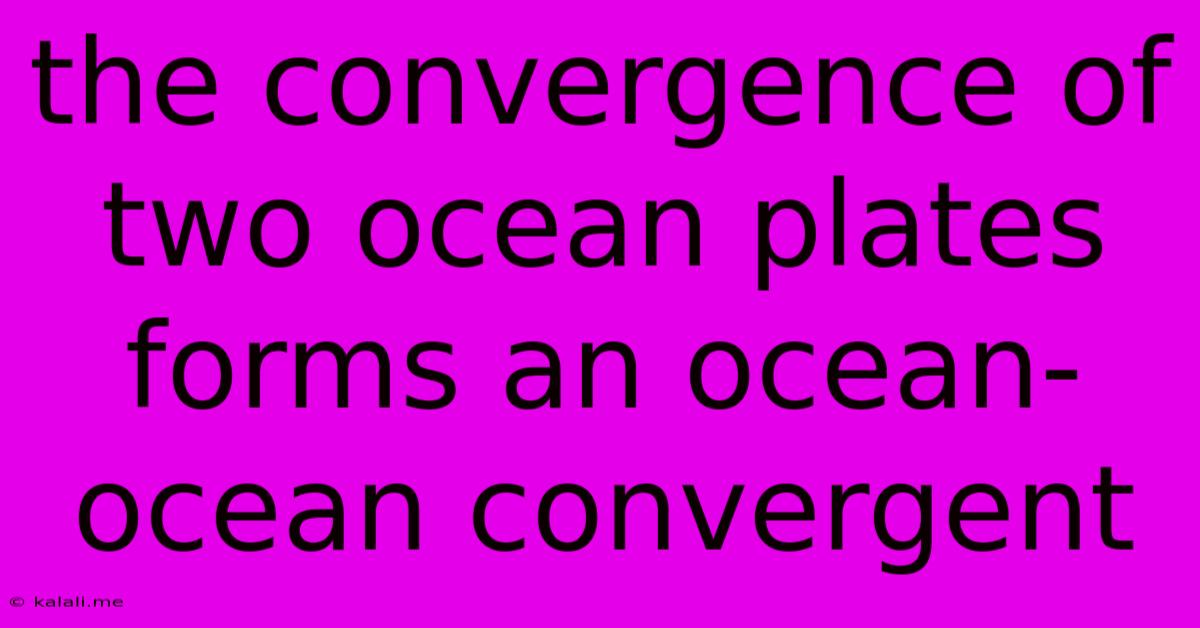The Convergence Of Two Ocean Plates Forms An Ocean-ocean Convergent
Kalali
May 10, 2025 · 3 min read

Table of Contents
The Convergence of Two Ocean Plates: Forming Ocean-Ocean Convergent Boundaries
Meta Description: Explore the fascinating geological process where two oceanic plates collide, resulting in the formation of ocean-ocean convergent boundaries. Learn about the features, processes, and consequences of this powerful interaction.
The Earth's lithosphere, its rigid outer shell, is fractured into massive tectonic plates that are constantly in motion. When these plates interact, a variety of geological phenomena occur, from the creation of mountain ranges to the formation of deep ocean trenches. One particularly dramatic interaction is the convergence of two oceanic plates, a process that shapes the ocean floor and influences global tectonic activity. This article delves into the mechanics, features, and consequences of ocean-ocean convergent boundaries.
Understanding Plate Tectonics and Convergence
Before diving into the specifics of ocean-ocean convergence, let's establish a foundational understanding. Plate tectonics is the theory explaining the movement of Earth's lithospheric plates. These plates float on the semi-molten asthenosphere, driven by convection currents within the Earth's mantle. When plates meet, they interact in three main ways: diverging (moving apart), transforming (sliding past each other), and converging (colliding).
Ocean-ocean convergence occurs when two oceanic plates collide. Because both plates are relatively dense, neither is easily subducted (forced beneath the other). Instead, a complex interaction ensues, leading to the formation of a distinctive geological feature: a subduction zone.
The Formation of Subduction Zones at Ocean-Ocean Convergent Boundaries
In most cases of ocean-ocean convergence, one plate, typically the older and denser plate, is forced beneath the other. This process, known as subduction, creates a deep ocean trench, a long, narrow depression in the ocean floor. The subducting plate bends downwards at the trench, creating a significant topographic feature. The angle of subduction can vary, influencing the resulting geological formations. The process of subduction isn't smooth; it's a complex interaction involving friction, pressure, and the release of water from the subducting plate. This water lowers the melting point of the mantle material above the subducting plate, leading to the formation of magma.
Island Arcs: Volcanic Manifestations of Ocean-Ocean Convergence
The magma generated by the subduction process rises to the surface, often resulting in volcanic activity. This volcanic activity typically manifests as a chain of volcanic islands known as an island arc. These arcs are parallel to the trench and are often characterized by intense seismic activity as well. Examples of island arcs formed by ocean-ocean convergence include the Mariana Islands and the Izu-Bonin-Mariana Arc in the western Pacific Ocean. The volcanic activity within these island arcs contributes significantly to the ongoing creation of new crustal material.
Other Geological Features Associated with Ocean-Ocean Convergence
Besides island arcs and deep-sea trenches, ocean-ocean convergence can also lead to the formation of other significant geological features, including:
- Accretionary wedges: These are masses of sediment and rock scraped off the subducting plate and accumulated at the edge of the overriding plate.
- Forearc basins: These are sedimentary basins located between the volcanic arc and the trench.
- Backarc basins: These are basins that form behind the volcanic arc, often associated with extensional forces related to the subduction process.
Seismic Activity and the Ring of Fire
Ocean-ocean convergence is often associated with significant seismic activity. The friction between the two colliding plates, and the breaking and shifting of rocks during subduction, generate earthquakes. Many of the world's most powerful earthquakes occur along ocean-ocean convergent boundaries. These boundaries contribute significantly to the "Ring of Fire," a zone of intense seismic and volcanic activity encircling the Pacific Ocean.
Conclusion: A Dynamic and Shaping Force
Ocean-ocean convergence is a dynamic geological process that profoundly shapes the Earth's crust and influences global tectonic activity. The interaction of two oceanic plates creates a variety of impressive and important geological features, from deep ocean trenches to volcanic island arcs. Understanding this process is crucial to comprehending the Earth's dynamic systems and the forces that have shaped our planet's surface over millions of years.
Latest Posts
Latest Posts
-
What Year Was I Born If Im 15
Jun 30, 2025
-
What Is The Easter Bunny Favorite Color
Jun 30, 2025
-
How Much Is 100 Gallons Of Diesel
Jun 30, 2025
-
How Much Is 50 Gallons Of Water
Jun 30, 2025
-
How Many Laps Around A Football Field Is A Mile
Jun 30, 2025
Related Post
Thank you for visiting our website which covers about The Convergence Of Two Ocean Plates Forms An Ocean-ocean Convergent . We hope the information provided has been useful to you. Feel free to contact us if you have any questions or need further assistance. See you next time and don't miss to bookmark.